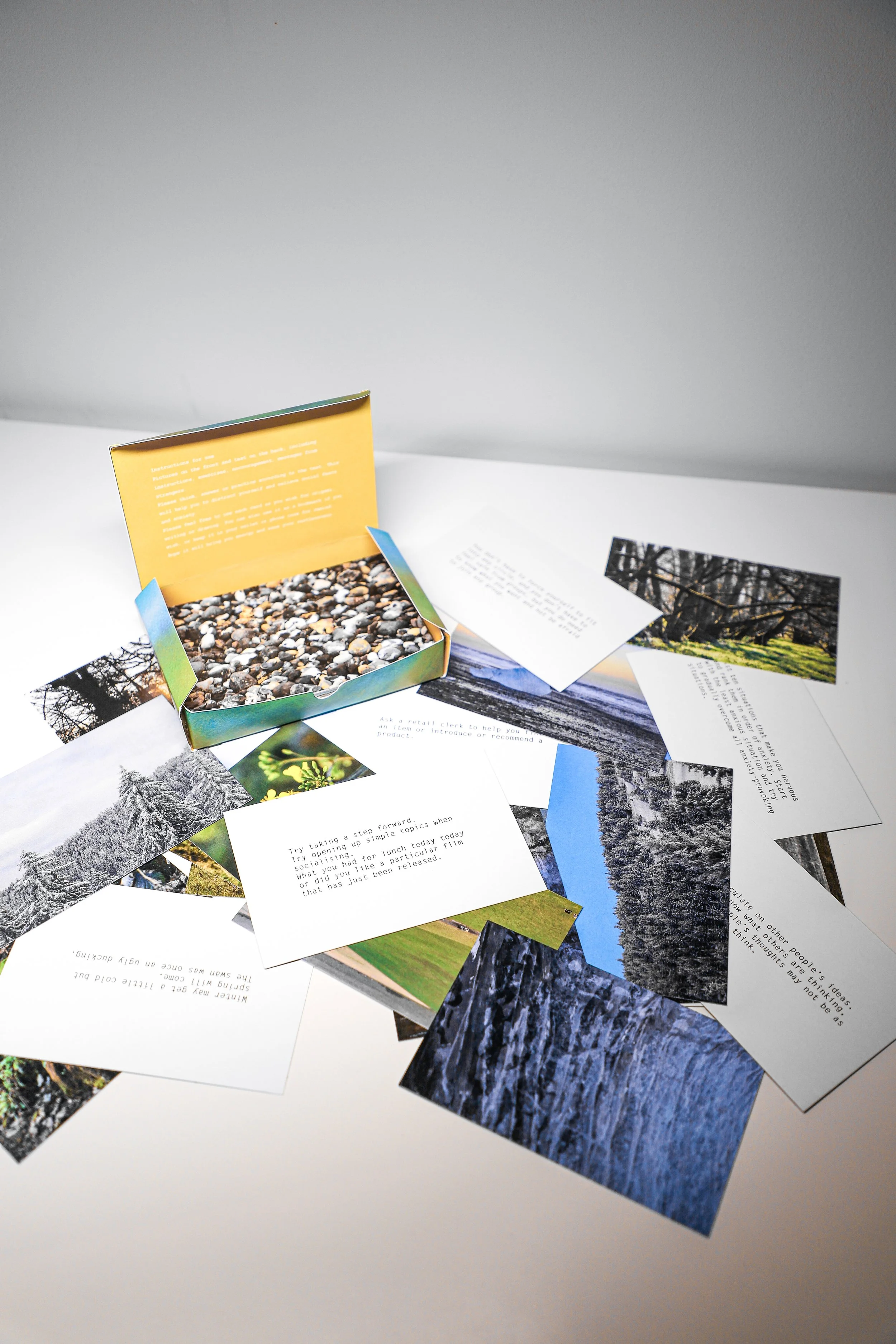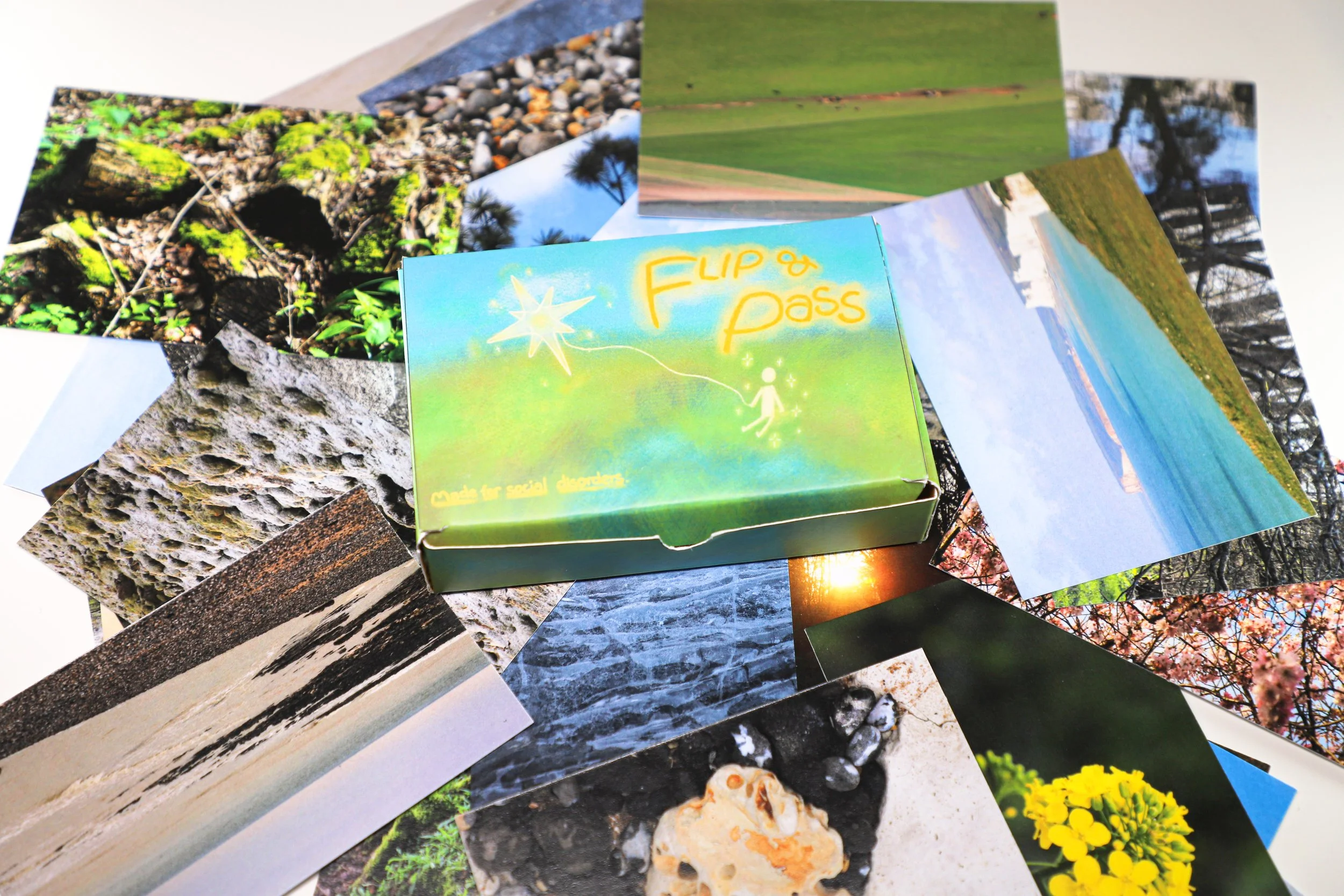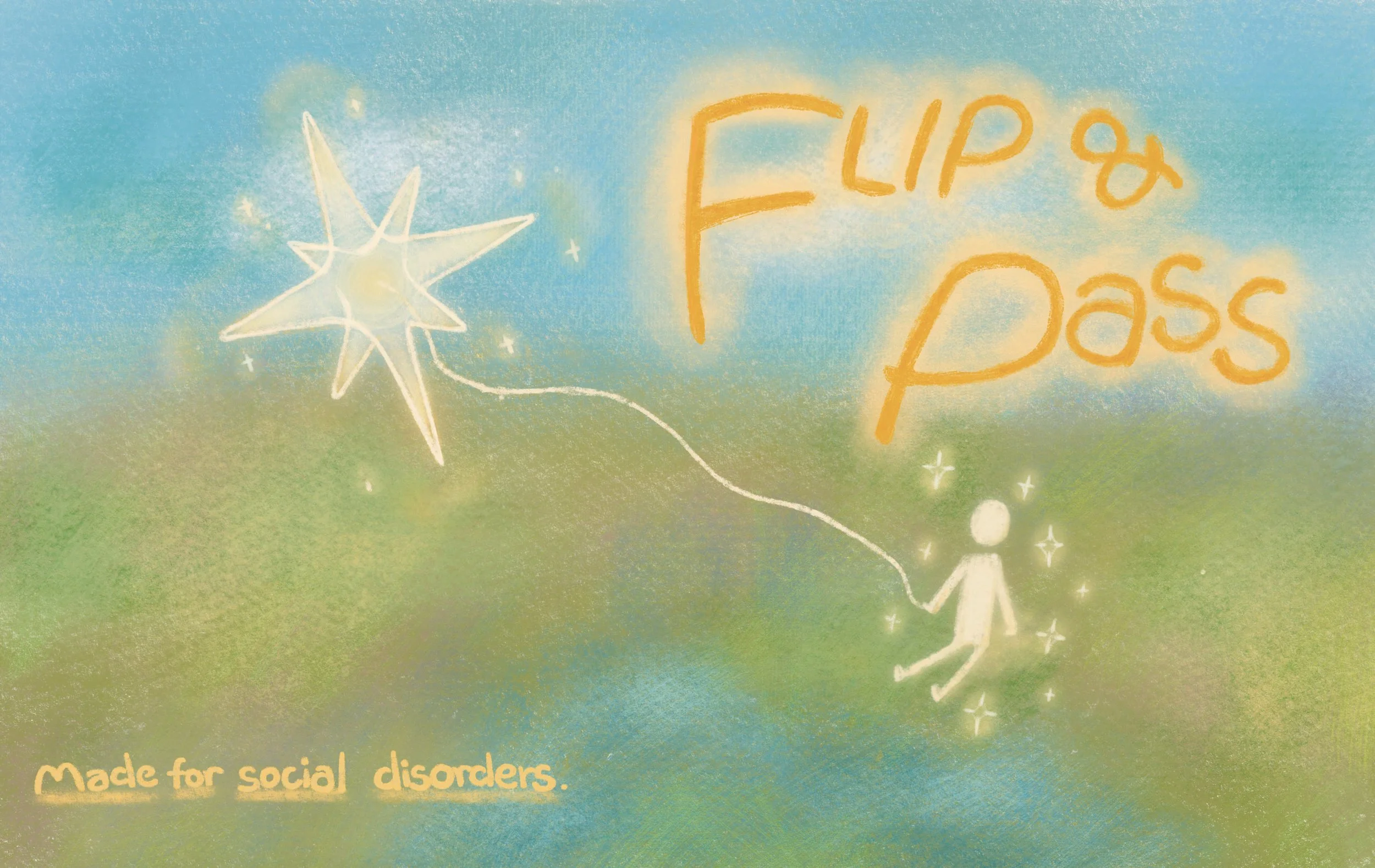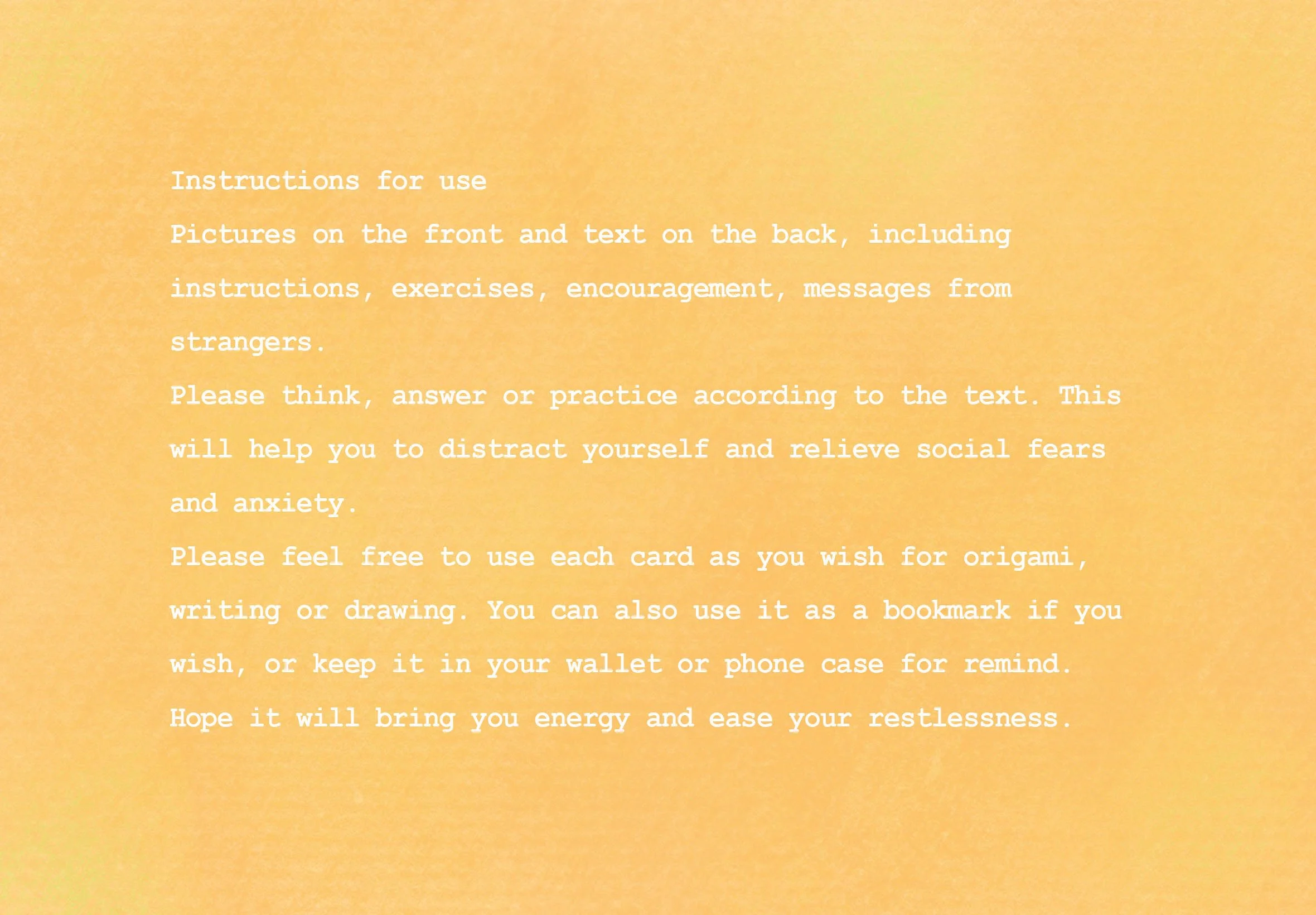Flip & Pass Part 2
120mm x 80mm x 20mm box with photography and text print on cards
FILP & PASS is a set of cards featuring social anxiety issues. The is designed to raise awareness of social anxiety and assist with treatment methods.
Social phobia is increasing year on year, especially amongst young people. Social anxiety can also lead to negative thoughts and low self-esteem, which can seriously affect the physical and mental health of people with social anxiety.
On one side of the card is a photo of nature and the text on the other side is some knowledge, socializing guidelines and mood-shifting instruction. It is hoped that by interacting with the cards, people will be able to reduce the psychological fear and anxiety associated with social disorders. Help people with social anxiety to feel comfortable and relaxed in their lives.
Social anxiety disorder (formerly "social phobia") was officially recognised as a separate phobia in the mid-1960s. (UK National Collaborating Center for Mental Health, 2013) Social anxiety disorder is a persistent fearful response to one or more social situations that affects a person's life both psychologically and physically. People with social phobia may feel nervous, anxious or fearful when in a crowd, or when talking to strangers. Symptoms such as restlessness, stuttering, nausea, rapid heartbeat, trembling, blankness of mind, dizziness, sweating, dry mouth, flushing, numbness of toes or fingers, upset stomach, and muscle tension are usually present. In life, severe cases may begin to avoid situations and environments where social phobia occurs, which often leads to a lot of inconvenience, loss of social life and even career prospects. Physically this affects their physical and mental health, thoughts and behaviours such as severe insomnia and alcoholism. It can even make them lose the idea of living. (BetterHealth Channel, 2012)
Most people experience mild social anxiety at some point, and it is one of the most common forms of anxiety. But contemporary young people are affected by the overall impact of structural factors such as digital media technology, education, culture and economic development. More and more have begun to suffer from social disorders as a result.2021 China Youth Daily research found that more than 80 per cent of college students consider themselves to be mildly socially phobic. (China Youth Daily, 2021, Page 11) They are used to talking to people online, enjoying the convenience of the virtual nature of social platforms and the protection of personal information and appearance. Gradually, they begin to be uncomfortable with interacting with people in real life, causing them to become less confident and afraid of face-to-face interaction, worrying about whether others will have negative opinions or judgements about them. This leads to more and more young people being reluctant to go out of their homes, ignoring the social value of real life and the objective world, and further contributing to real-life "group loneliness". This is the reason why I started to explore and develop this project, hoping to try to use my ability to help more young people in their lives to alleviate their problems.
Therefore, I began to think about how to serve this population, and I tried Therapeutic Photography using photography as an entry point and connecting it with art therapy, which is a form of psychological therapy that uses art media as a means of expression and communication to improve the treatment or intervention of the patient's psychological disorders. The creation or appreciation of art is used to help people explore emotions, develop self-awareness, cope with stress, enhance self-esteem, improve social skills and recover from illness. (Lefèvr et al., 2015, p. 376) Various studies have found that participating in and viewing visual art creations triggers a relaxation response in the body, which can help to lower stress and reduce symptoms of anxiety and depression. (Kaimal et al., 2016, p. 74) Photographs can be used for self-reflection, assisting recovery and reducing social exclusion as well as increasing self-knowledge, awareness, and well-being (PhotoTherapy Centre, 2014). I chose to take nature-based photographs as a resource. In a report by the Mental health foundation, it was found that 70 per cent of UK adults believe that being close to nature can improve their mood. (2021, Page 12) At St James's Hospital in Dublin, Ireland, there is a five-year arts-based intervention called OpenWindow. It includes nature-themed audiovisual artwork created by artists, and studies have found that patients treated with OpenWindow have lower levels of anxiety and depression.OpenWindow has also been found to reduce isolation and provide a connection to the outside world. (Fancourt, D., Finn, S., 2019) Therapeutic Photography and Natural Healing which have been scientifically recognised as having the ability to treat and improve mental health also bring science to the cards designed.
In order to better complement the images to achieve relief, I wanted to be able to present them by incorporating guided text. In order to increase the functionality of the cards, the text has been divided into several sections, combined with imagery, positive output and related exercises and tips. Some of the text on the back of the cards is descriptive and associative based on the images on the front, asking the user a series of questions and guidance about animals, everyday life and nature or whimsical ideas to try and remove them from the uncomfortable situation they find themselves in. A part of the text of the cards has an output about positive psychology and thinking, through the dissemination of relevant knowledge and questions to guide people with social phobia to increase their self-confidence and eliminate anxiety, so that they believe in their own abilities and in their ability to change, to overcome this disease. There is also a section on words from strangers, through messages from people who have also experienced social disorders, so that they can see more kindness from the community. The other section has some simple social exercises for people to try and use. From simple self-exercises to talking to strangers and related socialising tips.
It is hoped that a series of guidance can make people with social disorders less fearful of society, encourage them to get out of the house and rekindle their desire for nature and society, help them to rebuild new hope for socialising, and enhance their self-worth as well as their links with social life. Helping them to withdraw from negative emotions and helping people with social anxiety disorder to feel comfort and relief in their daily lives. The card format, through the medium of paper, allows this resource to be used in more life situations, such as on the underground without internet access, and the smaller size makes it easier to carry out of the house. The smaller size also makes it easier to carry on the go. It also provides the user with a short break from their mobile phone. The smaller size also makes it easier to carry around. The instructions also state that I want the user to use it in a way that is comfortable for them. You can write or draw on it, keep it in your wallet or use it as a bookmark to remind yourself. I also encourage you to use the cards with your friends or give them to someone close to you.
Better Health Channel (2012). Social phobia. [online] Vic.gov.au. Available at: https://www.betterhealth.vic.gov.au/health/conditionsandtreatments/social-phobia.
Cheng , S., Bi , R. and Wang, J. (2021). More than 80% of college students surveyed believe that they are slightly ‘socially afraid’. [online] p.11. Available at: https://zqb.cyol.com/html/2021-11/23/nw.D110000zgqnb_20211123_1-11.htm.
Fancourt, D. and Finn, S. (2019). What is the evidence on the role of the arts in improving health and well-being? A scoping review.[online] www.ncbi.nlm.nih.gov. WHO Regional Office for Europe. Available at: https://www.ncbi.nlm.nih.gov/books/NBK553778/.
Huang , D., Wang, D. and Yan, Y. (2020). More than 40% of young people call themselves ‘social phobic’ and social software has become the first choice among social media circles. [online] 21 Dec., p.4. Available at: https://zqb.cyol.com/html/2020-12/21/nw.D110000zgqnb_20201221_4-04.htm.
Kaimal, G., Ray, K. and Muniz, J. (2016). Reduction of Cortisol Levels and Participants’ Responses Following Art Making. Art Therapy, [online] 33(2), pp.74–
80. doi:https://doi.org/10.1080/07421656.2016.1166832.
Lefèvre, C., Ledoux, M. and Filbet, M. (2015). Art therapy among palliative cancer patients: Aesthetic dimensions and impacts on symptoms. Palliative and Supportive Care, 14(4), pp.376–380. doi:https://doi.org/10.1017/s1478951515001017.
Mental Health Foundation (2021). How Connecting with Nature Benefits Our Mental Health. [online] p.12. Available at: https://www.mentalhealth.org.uk/sites/default/files/2022-06/MHAW21-Nature-research-report.pdf.
National Collaborating Centre for Mental Health UK (2013). SOCIAL ANXIETY DISORDER. [online] Nih.gov. Available at: https://www.ncbi.nlm.nih.gov/books/NBK327674/.
PhotoTherapy Centre (2014). Therapeutic Photography. [online] PhotoTherapy & Therapeutic Photography Techniques. Available at: https://phototherapycentre.com/therapeutic-photography/.































































